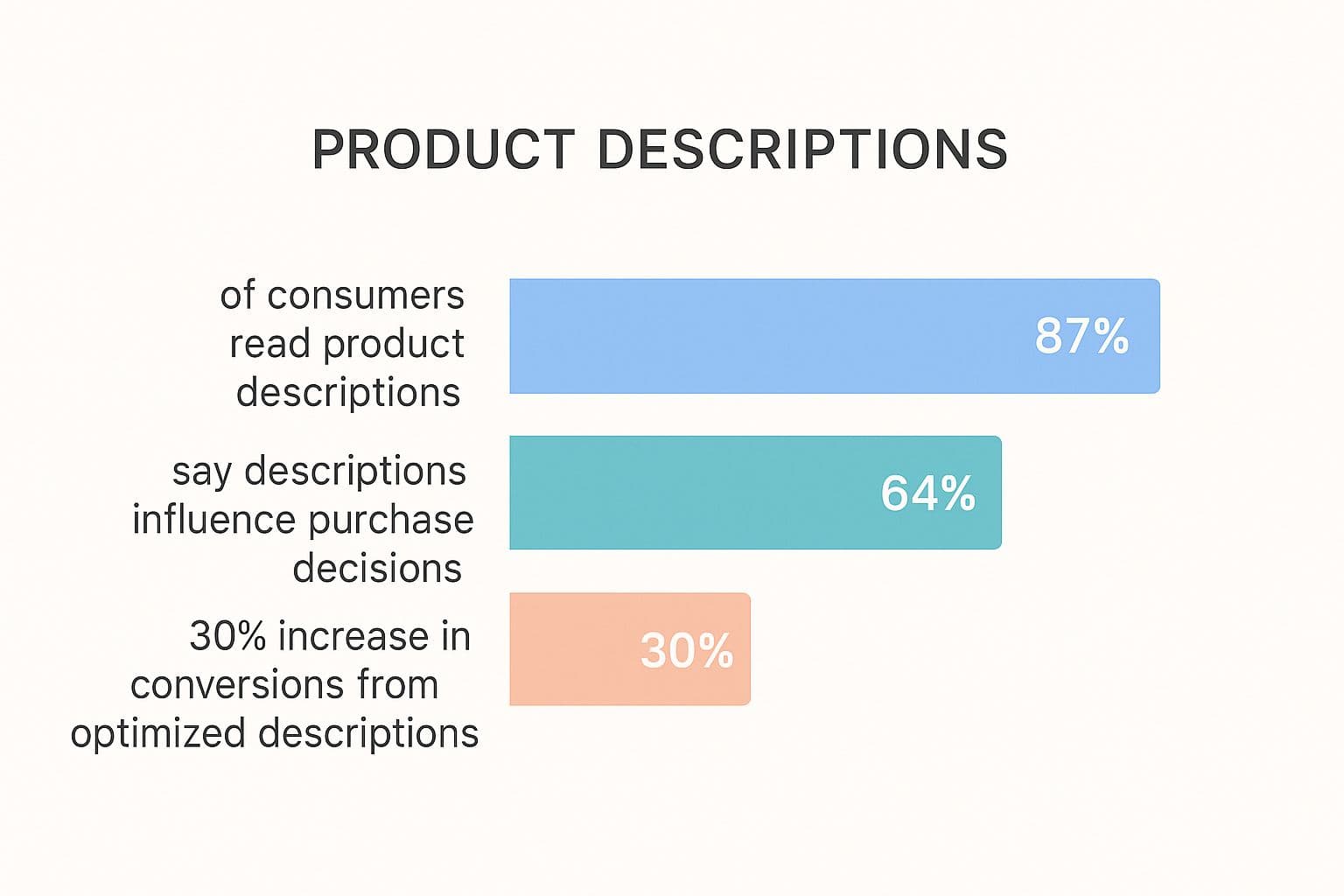How to Write Product Descriptions That Sell
Learn how to write product descriptions that connect with customers and boost sales. Our guide offers practical tips for ecommerce copywriting and SEO.

Let’s be honest, writing a product description that actually sells is so much more than just rattling off a list of features. It’s about spinning a yarn that hooks your ideal customer right from the first sentence. The real goal is to highlight the benefits of those features, talk in a voice that feels like your brand, and make sure the whole thing is a breeze to read, whether on a tiny phone screen or a giant monitor.
Why Your Product Descriptions Matter More Than Ever
Picture your product description as your best salesperson. This one works 24/7, doesn't need a coffee break, and has the power to turn a casual "just looking" browser into a paying customer. In the noisy world of e-commerce, a killer description is what lifts your product above the rest. It's your first—and sometimes only—chance to build trust and show people what you're all about.
A truly great description doesn't just describe. It gets inside your customer's head, answering their questions before they even have a chance to ask them. That simple move smoothes out the path to purchase and builds a solid layer of confidence.
The True Cost of Weak Descriptions
Here's a hard truth: skimping on your product page copy is a seriously expensive mistake. The data on consumer behavior backs this up completely. With over 80% of shoppers digging into online research before they buy, your description is often the last stop before they decide. In fact, some studies show that nearly 90% of shoppers say product content is a huge factor in their decision.
When a description is vague, misleading, or just plain lazy, you feel it directly in your return rates. Research has found that a whopping 64% of online returns happen simply because the product didn't live up to its description. You can dig deeper into how product information sways buyers if you're curious.
This image really drives home how much a few well-chosen words can impact customer behavior and, ultimately, your bank account.

The numbers don't lie. Most of your potential customers aren't just skimming your descriptions; they're studying them to make a final call.
The Shift From Feature-Listing to Benefit-Selling
If there’s one golden rule for writing product descriptions, it’s this: stop listing features and start selling benefits. It’s a subtle but powerful shift in thinking. Features tell a customer what a product is, but benefits explain what a product does for them.
Your customer doesn’t want a quarter-inch drill bit. They want a quarter-inch hole.
The magic happens when you connect the dots between your product's specs and what your customer actually wants to achieve in their life.
This little table breaks down the difference. It's a simple way to visualize how to transform your copy from a boring spec sheet into a compelling sales pitch.
| Focus Area | Feature-Focused (What to Avoid) | Benefit-Focused (What to Do) |
|---|---|---|
| Backpack | "Made with ripstop nylon." | "Go on any adventure without worrying about tears or snags." |
| Skincare | "Contains 1% hyaluronic acid." | "Achieve deep, lasting hydration for plump, dewy skin all day." |
| Coffee Maker | "Features a 12-cup carafe." | "Brew enough coffee for the whole family, so everyone starts their morning happy." |
See the difference? This approach turns a list of technical details into a story. It lets the customer imagine exactly how your product will solve their problem or make their life better, which is way more persuasive than a bunch of jargon. It's the difference between a product that just sits on a digital shelf and one that truly connects.
Defining Your Customer and Brand Voice

Before a single word of your product description gets written, you've got to hit pause and answer two huge questions: Who am I even talking to, and how do I want my brand to sound? It’s a classic mistake to think you can write for "everyone." Trust me, that's a surefire way to connect with absolutely no one.
The magic happens when a product description feels less like a sales pitch and more like a one-on-one conversation with the perfect customer. This is where the real work begins—long before you start listing features. If you want to get this right, you first need to learn how to identify your ideal customer and lay that groundwork.
Get to Know Your Ideal Customer
You’ve probably heard of a buyer persona. It’s basically a detailed profile of your perfect customer. But don't just stop at demographics like age and location. That's surface-level stuff. The goal is to create a character so real you could almost have a coffee with them.
What keeps them up at night? What are their biggest frustrations, and what secret solutions are they daydreaming about? When you know this, your product stops being just an "item" and becomes the exact answer they've been looking for.
For example, your persona for a high-performance running shoe isn't just "runners." Let’s get specific. It’s "Alex, 32, a busy professional who uses running to de-stress. They're training for their first half-marathon but are secretly terrified of getting injured." See? That detail gives your writing a laser-sharp focus.
A great product description doesn't just sell a product; it solves a problem for a specific person. When you know the person, you know the problem.
This approach changes everything. For Alex, you wouldn’t just say the shoe has "cushioned soles." You’d talk about "cloud-like shock absorption that protects your knees on those long, grueling training runs." You’re speaking directly to their biggest fear.
Find Your Unmistakable Brand Voice
Okay, so you know who you’re talking to. Now, who are you? Your brand voice is the personality that shines through in every email, social post, and product description. When it's consistent, it builds trust and makes you unforgettable.
So, who are you? The witty friend dishing out great advice? Or the calm, knowledgeable expert people turn to for reassurance? There's no single right answer, but it must match your product and your audience. A company selling quirky novelty socks is going to sound way different than one selling financial software.
To find your voice, ask yourself these questions:
- If my brand were a person, what three words would describe them? (e.g., Playful, Sarcastic, Helpful)
- What's our relationship with the customer? (e.g., Coach, Best Friend, Expert Guide)
- How do we want people to feel after reading our stuff? (e.g., Inspired, Reassured, Amused)
Answering these helps you build a voice that feels genuine on every single page. If you're stuck, checking out different brand voice examples can show you how the pros do it. Nailing this ensures every word you write strengthens your brand.
Writing Copy That Actually Sells
Alright, you've done your homework. You know your audience and you've nailed down your brand voice. Now for the fun part: turning all that strategic thinking into words that make people want to buy. This is where the rubber meets the road, and it all kicks off with a killer opening line.
Think about it—you have maybe a second or two to grab someone's attention as they scroll. Don't blow it by listing dry specifications. Hook them immediately. Lead with the most powerful benefit, touch on a relatable pain point, or ask a question that makes them nod their head.
Instead of saying a portable charger has a "5,000mAh battery," try something like, "Tired of that dreaded 1% battery warning?" Boom. You’ve just connected with a universal frustration, and now they're listening.
From Features to Feelings
I know we've mentioned this before, but it’s so critical it’s worth drilling down on. People don't buy a product; they buy a better version of themselves. Your job is to paint a vivid picture of what their life looks like with your product in it. My favorite trick for this is the "So What?" test.
It's simple. Take any feature of your product and just ask, "So what?" Keep asking until you get to a real, human-level benefit.
- Feature: This jacket uses waterproof Gore-Tex fabric.
- So what? It means you won't get wet when it rains.
- So what? It means you can actually enjoy that hike you planned, staying totally comfortable and protected even if the weather turns nasty.
See that last answer? That’s the gold. You're not selling a textile; you're selling an uninterrupted, enjoyable experience. That's what people pay for.
Write for the Senses
The biggest hurdle in e-commerce is that shoppers can't physically interact with your stuff. They can't feel the texture, smell the scent, or see it with their own eyes. This is where sensory words become your superpower, helping you close that gap. They make your products feel real and far more memorable.
A blanket isn't just "soft." Is it "buttery-soft"? Or maybe "cloud-like" or "velvety"? A candle isn't just "nice-smelling." It has notes of "smoky cedarwood" and "a hint of crisp pine." These words fire up the brain's sensory centers, helping the reader almost experience the product right there on the screen.
Good copy makes you understand something. Great copy makes you feel something. Tapping into the senses is the fastest way to get there.
Don't underestimate this. Emotion is a massive driver of purchasing decisions. One study even found that ad campaigns with purely emotional content performed almost twice as well (31% vs. 16%) as those that were strictly rational.
Make It Scannable (Please!)
Let's be real: nobody is going to read a giant wall of text, especially on a phone. The way you format your description is just as crucial as the words you choose. You need to design it for the scanner—the person whose eyes are darting around the page looking for the highlights.
Here’s a simple checklist for making your copy easy to digest:
- Catchy Subheadings: Break up your text with clear, benefit-focused headers. Think "All-Day Comfort for Your Busiest Days" instead of just "Features."
- Lean on Bullet Points: They are your best friend for listing key features, specs, or benefits. They’re just so much easier to read than a long, rambling sentence.
- Use Bold Text: Be strategic with bolding. Make your guarantees, key stats, or standout selling points pop off the page.
- Short Paragraphs: Aim for just one core idea per paragraph, keeping them to two or three sentences, tops. The white space makes the whole page feel more approachable.
When you structure your descriptions this way, you're serving both the scanners and the detail-oriented readers. Everyone gets what they need to feel confident enough to click "add to cart."
Weaving SEO into Your Product Descriptions

So, you've written a fantastic product description. It's persuasive, compelling, and packed with personality. But here's the tough truth: if your customers can't find it, it might as well not exist. This is where search engine optimization (SEO) enters the picture, making sure your brilliant copy actually gets in front of the people ready to click "buy."
Don't let the acronym "SEO" scare you off. It's not some dark art. At its heart, it’s just about using the same words and phrases your customers are already typing into Google. Think of it as speaking their language so the search engines can play matchmaker.
The need for high-quality online content is exploding. The content writing services market was already worth around USD 19.9 billion in 2023 and is on track to nearly double by 2033. Businesses are catching on that great copy is a non-negotiable for getting seen online.
Finding Your Keywords
First things first, you need to figure out what search terms people are actually using. This isn't just about guessing the product name. You're hunting for long-tail keywords—those longer, super-specific phrases that scream, "I'm ready to buy!"
For example, a search for "shoes" is just window shopping. But a search for "waterproof trail running shoes for wide feet"? That person knows exactly what they need, and they're the customer you want.
A dead-simple way to start finding these is to type your product into Google and see what the search bar auto-suggests. Those suggestions come directly from real user searches. Another goldmine is the "People Also Ask" box in the search results. These are literal questions from potential buyers, giving you perfect, natural-sounding phrases to work into your copy.
Where to Place Your Keywords
Okay, you've got your list of keywords. Now what? The trick is to weave them into your description so it still sounds like a human wrote it, not a keyword-stuffing robot. To make sure your descriptions resonate with customers and rank well, it's worth brushing up on essential content SEO best practices.
Here are the prime spots to place your keywords for maximum impact:
- Product Title: This is your headline. It’s the most important real estate, so get your main keyword in there and keep it clear.
- Headings and Subheadings: Breaking up your description with H2 or H3 tags is great for readability and a perfect place for secondary keywords.
- Body Copy: Naturally sprinkle your primary and secondary keywords throughout the text. Try to get your most important one in the first 100 words.
- Image Alt Text: This text describes your image for search engines and visually impaired users. It's an easy win for adding a relevant keyword.
Here’s a critical piece of advice I give every e-commerce client: Never, ever use the manufacturer's default description. It’s a one-way ticket to a duplicate content penalty from Google, which will bury your product page in the search results. Always write your own.
By being thoughtful about where you place your keywords, you're not just pleasing an algorithm. You’re making your page more relevant and helpful for your customers. This attracts better-qualified traffic and, ultimately, leads to more sales without spending a dime on ads.
Using AI to Write Better (and Way Faster)
Let's be real: AI is a total game-changer for writing product descriptions. But it's not some magic button you press to have a robot do all the work. The trick is to think of AI as your super-smart creative partner, not a replacement for your own brain.
When you use it right, AI can obliterate writer's block, spitball new angles you hadn't considered, and whip up a solid first draft in seconds. Your job is to then come in and sprinkle that human magic—your brand's personality, your deep customer knowledge—on top.
This blend of machine speed and human insight is where the magic happens. For anyone trying to grow their business, AI tools can help you scale your content creation efforts effortlessly. You're not just making more content; you're making better content in a fraction of the time.
And the demand for great product copy is exploding. By 2025, the global market for content writing services is expected to reach a massive USD 22.63 billion. The product description slice of that pie? It’s projected to be the biggest, at around 37.4%. That tells you everything you need to know about how critical this skill is. If you're a data nerd, you can dig into more market insights here.
The Secret is in the Prompt
Garbage in, garbage out. It’s the oldest rule in tech, and it’s especially true for AI. If you give a lazy prompt, you’ll get a lazy, generic result.
Asking an AI to "write a product description for a coffee mug" is a recipe for boredom. You have to give it more to work with. Get specific. Give it context.
Try something like this instead:
"You are a copywriter for a brand that sells artisanal home goods. Our brand voice is warm, mindful, and a bit rustic. Write a 150-word product description for our 'Sunrise' ceramic coffee mug. Your target audience is a busy young professional who craves a quiet morning ritual. Focus on the feeling of starting the day with a moment of calm. Don't forget to mention it's handcrafted and dishwasher-safe."
See the difference? Now the AI isn't just describing an object; it's selling an experience. It’s no longer just a mug. It's a tool for a better morning.
AI Is More Than a First-Draft Machine
Generating that initial text is just the beginning. The real power comes from using AI as an editing and brainstorming partner throughout the entire process.
Once you have a draft you're okay with, you can use AI to really make it sing. Here are a few prompts I use all the time:
- Tweak the Vibe: "Make this sound more playful." Or, "Rewrite this in a professional, reassuring tone for a skeptical customer."
- Cut the Fluff: A simple "Simplify this paragraph" or "Make this sentence punchier" can fix clunky writing in a snap.
- Connect Features to Feelings: Take a feature like "Made with 100% organic cotton" and ask the AI to "List 5 emotional benefits of this feature for a new parent buying baby clothes."
- Stretch Your Content Further: AI is fantastic at adapting your best descriptions for other channels. You can easily turn a detailed product page into a snappy Instagram caption or a few bullet points for an email. Learning the ropes of AI-powered content repurposing is a massive time-saver for any marketing team.
Treat AI like the versatile assistant it is. You bring the strategy, the final approval, and the human touch. Let the AI do the heavy lifting. You'll find yourself writing better, more persuasive product descriptions, and you'll be doing it faster than ever before.
Got Questions About Product Descriptions? We've Got Answers

Even with the best game plan, you're bound to run into some tricky questions when you sit down to write. It happens to all of us. Let's walk through some of the most common snags people hit when trying to craft product descriptions that actually work.
This is your go-to troubleshooting guide for things like ideal word count, how to spice up "boring" products, and more. Nailing these little details can be what turns a casual browser into a loyal customer.
So, How Long Should a Product Description Be?
This is the big one, right? Everyone wants a magic number, but truthfully, it doesn't exist. The right length completely depends on the product. A quirky coffee mug? You can probably say everything you need to in 50-100 words. A professional-grade camera drone? That's a different story. You'll likely need 300+ words to build confidence and cover all the bases for such a big purchase.
I've found the best strategy is to layer your information. Think of it as a pyramid:
- The Tip (For the Scanners): Start with a powerful 2-3 sentence summary that gets right to the main benefit.
- The Middle (For the Skimmers): Follow up with a clean, bulleted list of the top features and what they mean for the customer.
- The Base (For the Deep Divers): Finish with a more detailed paragraph for those who want the full scoop before they buy.
This approach caters to every kind of shopper, from the person in a rush to the meticulous researcher.
What's the Single Biggest Mistake People Make?
Easy. Using the manufacturer's description. It’s so tempting to just copy and paste, I get it. But it's a huge mistake for your SEO. It flags your page as duplicate content, and search engines really don't like that. It can tank your visibility.
Besides the SEO hit, those descriptions are almost always stiff, packed with jargon, and have zero personality. Your brand's voice is what sets you apart. Always, always write your own copy. It’s how you stand out, rank higher, and actually connect with people.
Never settle for the default description. Writing your own is a non-negotiable for two reasons: it gives you a unique voice and it's essential for good SEO.
How Can I Write a Great Description for a "Boring" Product?
First, let's toss out the word "boring." No product is truly boring because every single one solves a problem for somebody. That's your secret weapon. Shift your focus from the object to the outcome.
Instead of describing the chemical formula of a drain cleaner, write about the sheer relief of watching the water go down without facing a massive plumber's bill. For an ergonomic office chair, don't just list its adjustable levers. Paint a picture of ending a long workday feeling refreshed, not hunched over with a sore back.
Get right to the heart of your customer's frustration and show them how your product is the hero that swoops in to save the day.
And remember, writing is a process of refinement. It's always a good idea to have a system for polishing your work. A solid content review process ensures that every description you publish is sharp, on-brand, and ready to convert.
Ready to make your writing process faster and smarter? TypeBoost is a lightweight app for macOS that lets you apply your favorite AI prompts to any text, anywhere, with a simple keyboard shortcut. Stop copy-pasting and start creating better content in a fraction of the time.